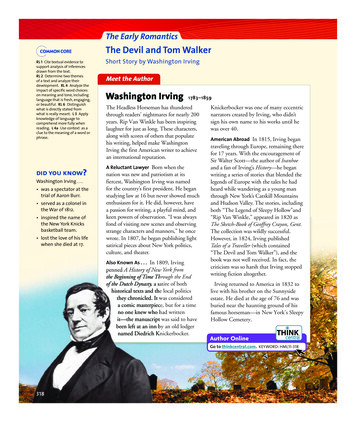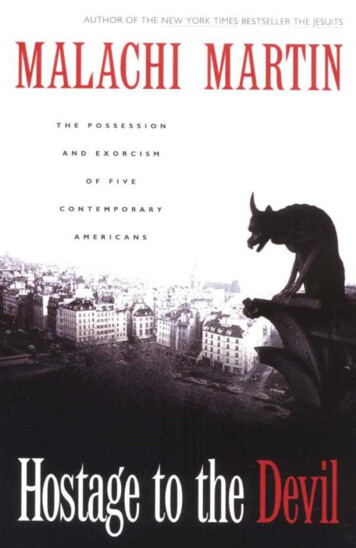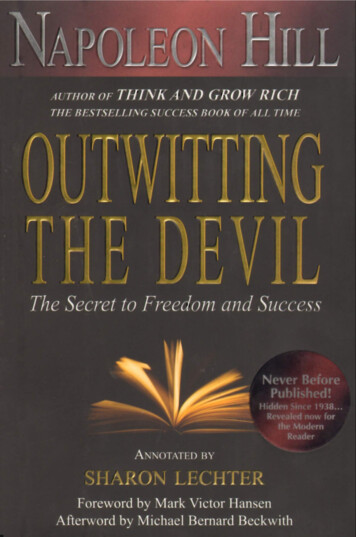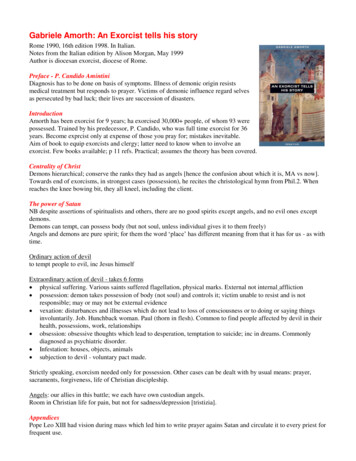
Transcription
The Early RomanticsThe Devil and Tom WalkerRL 1 Cite textual evidence tosupport analysis of inferencesdrawn from the text.RL 2 Determine two themesof a text and analyze theirdevelopment. RL 4 Analyze theimpact of specific word choiceson meaning and tone, includinglanguage that is fresh, engaging,or beautiful. RL 6 Distinguishwhat is directly stated fromwhat is really meant. L 3 Applyknowledge of language tocomprehend more fully whenreading. L 4a Use context as aclue to the meaning of a word orphrase.did you know?Washington Irving . . . was a spectator at thetrial of Aaron Burr. served as a colonel inthe War of 1812. inspired the name ofthe New York Knicksbasketball team. lost the love of his lifewhen she died at 17.Short Story by Washington IrvingMeet the AuthorWashington Irving1783–1859The Headless Horseman has thunderedthrough readers’ nightmares for nearly 200years. Rip Van Winkle has been inspiringlaughter for just as long. These characters,along with scores of others that populatehis writing, helped make WashingtonIrving the first American writer to achievean international reputation.A Reluctant Lawyer Born when thenation was new and patriotism at itsfiercest, Washington Irving was namedfor the country’s first president. He beganstudying law at 16 but never showed muchenthusiasm for it. He did, however, havea passion for writing, a playful mind, andkeen powers of observation. “I was alwaysfond of visiting new scenes and observingstrange characters and manners,” he oncewrote. In 1807, he began publishing lightsatirical pieces about New York politics,culture, and theater.Also Known As . . . In 1809, Irvingpenned A History of New York fromThrough the Endthe Beginning of Time Thsatire of bothof the Dutch Dynasty, a sahistorical texts and the local politicswas consideredthey chronicled. It wmasterpiece, but for a timea comic masterpiechad writtenno one knew who hit—the manuscript was said to havebeen left at an inn bby an old lodgerKnickerbocker.named Diedrich KnKnickerbocker was one of many eccentricnarrators created by Irving, who didn’tsign his own name to his works until hewas over 40.American Abroad In 1815, Irving begantraveling through Europe, remaining therefor 17 years. With the encouragement ofSir Walter Scott—the author of Ivanhoeand a fan of Irving’s History—he beganwriting a series of stories that blended thelegends of Europe with the tales he hadheard while wandering as a young manthrough New York’s Catskill Mountainsand Hudson Valley. The stories, includingboth “The Legend of Sleepy Hollow”and“Rip Van Winkle,” appeared in 1820 asThe Sketch-Book of Geoffrey Crayon, Gent.The collection was wildly successful.However, in 1824, Irving publishedTales of a Traveller (which contained“The Devil and Tom Walker”), and thebook was not well received. In fact, thecriticism was so harsh that Irving stoppedwriting fiction altogether.Irving returned to America in 1832 tolive with his brother on the Sunnysideestate. He died at the age of 76 and wasburied near the haunting ground of hisfamous horseman—in New York’s SleepyHollow Cemetery.Author OnlineGo to thinkcentral.com. KEYWORD: HML11-318318NA L11PE-u02s12-brDev.indd31812/10/103:33:51 PM
text analysis: satireIrving was a master of satire, a literary device in which people,customs, or institutions are ridiculed with the purposeof improving society. In this passage, Irving pokes fun atquarrelsome, complaining women:. . . Though a female scold is generally considered to be amatch for the devil, yet in this instance she appears to havehad the worst of it.Satire is often subtle, so as you read, watch for its indicators:humor, exaggeration, absurd situations, and irony.reading skill: analyze imageryIrving develops his characters and establishes mood throughimagery—words and phrases that appeal to the five senses. . . There lived near this place a meager, miserly fellow, of thename of Tom Walker. He had a wife as miserly as himself. . . .They lived in a forlorn-looking house that stood alone and hadan air of starvation.As you read, use a chart like the one below to record imagesfrom the story. Also include your inferences about how theimages support the story’s characters and mood.ImagesCharacterizationMoodhouse with a look ofstarvationTom and his wife aremiserly.depressingAre you willingto pay anyprice?People who’ll stop at nothing to achievewealth, success, or fame are oftensaid to have “sold their soul.” In otherwords, they have sacrificed somethingimportant—moral beliefs, privacy,family—in order to get what they want.Consider this kind of trade-off. Doyou think it might ever be worth theconsequences?DISCUSS Working with a partner, listseveral people—real or fictional—whofit this profile. Then pick one suchperson and list his or her gains and theirconsequences. Assign a value to eachitem and decide whether, overall, theprize was worth the price. Share yourconclusions with the rest of the class.Review: Make Inferencesvocabulary in contextThe following words are critical to the story of a miser whowould trade his soul for money. Check your understandingof each one by rewording the sentence in which it appears.1. The melancholy sight of the graveyard chilled him.2. The persecution of the Puritans went unchallenged.3. The mention of gold awakened his avarice.4. The corrupt usurer charged 20 percent interest.5. Speculating in land deals held the promise of quick profits.6. Hard economic times are propitious for moneylenders.7. People who flaunt their wealth are guilty of ostentation.8. He was a strict censurer of other people’s vices.Complete the activities in your Reader/Writer Notebook.319NA L11PE-u02s12-brDev.indd31911/22/102:31:33 PM
devilTheTomandWalkerWashingtonIrvingbackground The story of Tom Walker is a variation on the legend of Faust, a 16thcentury magician and astrologer who was said to have sold his soul to the devil forwisdom, money, and power. Washington Irving reinvented the tale, setting it in the1720s in an area of New England settled by Quakers and Puritans. In Irving’s comicretelling of the legend, the writer satirizes people who present a pious public imageas they “sell their soul” for money.Analyze Visuals10A few miles from Boston in Massachusetts, there is a deep inlet, winding severalmiles into the interior of the country from Charles Bay, and terminating in athickly wooded swamp or morass. On one side of this inlet is a beautiful darkgrove; on the opposite side the land rises abruptly from the water’s edge into ahigh ridge, on which grow a few scattered oaks of great age and immense size.Under one of these gigantic trees, according to old stories, there was a greatamount of treasure buried by Kidd the pirate. The inlet allowed a facility to bringthe money in a boat secretly and at night to the very foot of the hill; the elevationof the place permitted a good lookout to be kept that no one was at hand; whilethe remarkable trees formed good landmarks by which the place might easily befound again. The old stories add, moreover, that the devil presided at the hidingof the money and took it under his guardianship; but this, it is well-known, healways does with buried treasure, particularly when it has been ill-gotten. Be thatas it may, Kidd never returned to recover his wealth; being shortly after seized atBoston, sent out to England, and there hanged for a pirate. a320unit 2: american romanticismNA L11PE-u02s12-Devil.indd320Artist John Quidor is wellknown for his series offantastic paintings basedon Irving’s writings. In thisdetail, a man discoversa store of hidden gold.What clues from thepainting’s images, colors,and dark tones helpyou visualize and betterunderstand the imageryin the story?a IMAGERYReread lines 1–15. Whatdetails in the descriptionsuggest that this is anill-fated place?Detail of The Money Diggers (1832), John Quidor. Brooklyn Museum of Art/Corbis.11/22/102:29:59 PM
NA L11PE-u02s12-Devil.indd32111/22/102:30:14 PM
20304050About the year 1727, just at the time that earthquakes were prevalent in NewEngland, and shook many tall sinners down upon their knees, there lived near thisplace a meager, miserly fellow, of the name of Tom Walker. He had a wife as miserly as himself: they were so miserly that they even conspired to cheat each other.Whatever the woman could lay hands on, she hid away; a hen could not cacklebut she was on the alert to secure the new-laid egg. Her husband was continuallyprying about to detect her secret hoards, and many and fierce were the conflictsthat took place about what ought to have been common property. They lived ina forlorn-looking house that stood alone and had an air of starvation. A few straggling savin trees, emblems of sterility, grew near it; no smoke ever curled from itschimney; no traveler stopped at its door. A miserable horse, whose ribs were asarticulate as the bars of a gridiron,1 stalked about a field, where a thin carpet ofmoss, scarcely covering the ragged beds of puddingstone,2 tantalized and balkedhis hunger; and sometimes he would lean his head over the fence, look piteouslyat the passerby and seem to petition deliverance from this land of famine. bThe house and its inmates had altogether a bad name. Tom’s wife was a talltermagant,3 fierce of temper, loud of tongue, and strong of arm. Her voice wasoften heard in wordy warfare with her husband; and his face sometimes showedsigns that their conflicts were not confined to words. No one ventured, however,to interfere between them. The lonely wayfarer shrunk within himself at thehorrid clamor and clapper-clawing;4 eyed the den of discord askance;5 andhurried on his way, rejoicing, if a bachelor, in his celibacy. cOne day that Tom Walker had been to a distant part of the neighborhood, hetook what he considered a shortcut homeward, through the swamp. Like mostshortcuts, it was an ill-chosen route. The swamp was thickly grown with greatgloomy pines and hemlocks, some of them ninety feet high, which made it darkat noonday, and a retreat for all the owls of the neighborhood. It was full of pitsand quagmires, partly covered with weeds and mosses, where the green surfaceoften betrayed the traveler into a gulf of black, smothering mud; there were alsodark and stagnant pools, the abodes of the tadpole, the bullfrog, and the watersnake; where the trunks of pines and hemlocks lay half-drowned, half-rotting,looking like alligators sleeping in the mire. dTom had long been picking his way cautiously through this treacherous forest;stepping from tuft to tuft of rushes and roots, which afforded precarious footholdsamong deep sloughs; or pacing carefully, like a cat, along the prostrate trunks oftrees; startled now and then by the sudden screaming of the bittern,6 or the quacking of wild duck rising on the wind from some solitary pool. At length he arrivedat a firm piece of ground, which ran out like a peninsula into the deep bosom ofthe swamp. It had been one of the strongholds of the Indians during their warsL 4aLanguage CoachMultiple-Meaning WordsFind “common property”in line 23. Common heremeans “shared.” Whatmeaning does commonhave in the expressioncommon thief?b IMAGERYIdentify the images inlines 16–30 that help tocharacterize Tom and hiswife. What charactertraits do these imagesreveal?cSATIREIn lines 31–37, Irvingsatirizes scolding womenand the institutionof marriage. Whathumorous detailsindicate this satire?d IMAGERYWhat kind of moodis established by thedescription of the swampin lines 40–47?1. as articulate . . . gridiron: as clearly separated as the bars of a grill.2. puddingstone: a rock consisting of pebbles and gravel cemented together.3. termagant (tûr mE-gEnt): a quarrelsome, scolding woman.4. clapper-clawing: scratching or clawing with the fingernails.5. eyed . . . askance (E-skBns ): looked disapprovingly at the house filled with arguing.6. bittern: a wading bird with mottled, brownish plumage and a deep, booming cry.322unit 2: american romanticismNA L11PE-u02s12-Devil.indd32212/10/103:37:59 PM
60708090with the first colonists. Here they had thrown up a kind of fort, which they hadlooked upon as almost impregnable, and had used as a place of refuge for theirsquaws and children.Nothing remained of the old Indian fort but a few embankments, graduallysinking to the level of the surrounding earth, and already overgrown in part byoaks and other forest trees, the foliage of which formed a contrast to the darkpines and hemlocks of the swamp.It was late in the dusk of evening when Tom Walker reached the old fort, andhe paused there awhile to rest himself. Anyone but he would have felt unwillingto linger in this lonely, melancholy place, for the common people had a badopinion of it, from the stories handed down from the time of the Indian wars,when it was asserted that the savages held incantations7 here, and made sacrificesto the evil spirit.Tom Walker, however, was not a man to be troubled with any fears of the kind.He reposed himself for some time on the trunk of a fallen hemlock, listening tothe boding cry of the tree toad, and delving with his walking staff into a moundof black mold at his feet. As he turned up the soil unconsciously, his staff struckagainst something hard. He raked it out of the vegetable mold, and lo! a clovenskull, with an Indian tomahawk buried deep in it, lay before him. The rust on theweapon showed the time that had elapsed since this death-blow had been given.It was a dreary memento of the fierce struggle that had taken place in this lastfoothold of the Indian warriors.“Humph!” said Tom Walker, as he gave it a kick to shake the dirt from it. e“Let that skull alone!” said a gruff voice. Tom lifted up his eyes, and beheld agreat black man seated directly opposite him, on the stump of a tree. He was exceedingly surprised, having neither heard nor seen anyone approach; and he wasstill more perplexed on observing, as well as the gathering gloom would permit,that the stranger was neither Negro nor Indian. It is true he was dressed in a rudehalf-Indian garb, and had a red belt or sash swathed round his body; but his facewas neither black nor copper-color, but swarthy and dingy, and begrimed withsoot, as if he had been accustomed to toil among fires and forges. He had a shockof coarse black hair, that stood out from his head in all directions, and bore an axon his shoulder.He scowled for a moment at Tom with a pair of great red eyes.“What are you doing on my grounds?” said the black man, with a hoarse,growling voice.“Your grounds!” said Tom, with a sneer, “no more your grounds than mine;they belong to Deacon Peabody.”“Deacon Peabody be d—d,” said the stranger, “as I flatter myself he will be,if he does not look more to his own sins and less to those of his neighbors. Lookyonder, and see how Deacon Peabody is faring.”melancholy(mDlPEn-kJl C) adj.gloomy; sadeMAKE INFERENCESLook again at lines 68 and77. What can you inferabout Tom Walker fromhis reaction to the swampand to his grisly discoveryof the skull?7. incantations: verbal charms or spells recited to produce a magic effect.the devil and tom walkerNA L11PE-u02s12-Devil.indd32332311/22/102:30:21 PM
The Devil and Tom Walker (1856), John Quidor. Oil on canvas, 68.8 cm 86.6 cm. The Cleveland Museum of Art, Mr. and Mrs. William H. Marlatt Fund, 1967.18.324Analyze VisualsThis Quidor paintingillustrates the firstmeeting between Tomand the devil. In youropinion, how well dothe artist’s choices ofcolor and shading andhis depiction of Tom’scharacter match thestory? Explain.unit 2: american romanticismNA L11PE-u02s12-Devil.indd32411/22/102:30:21 PM
100110120130Tom looked in the direction that the stranger pointed, and beheld one of the greattrees, fair and flourishing without, but rotten at the core, and saw that it had beennearly hewn through, so that the first high wind was likely to blow it down. On thebark of the tree was scored the name of Deacon Peabody, an eminent man, who hadwaxed wealthy by driving shrewd bargains with the Indians. He now looked around,and found most of the tall trees marked with the name of some great man of thecolony, and all more or less scored by the ax. The one on which he had been seated,and which had evidently just been hewn down, bore the name of Crowninshield; andhe recollected a mighty rich man of that name, who made a vulgar display of wealth,which it was whispered he had acquired by buccaneering.8 f“He’s just ready for burning!” said the black man, with a growl of triumph.“You see, I am likely to have a good stock of firewood for winter.”“But what right have you,” said Tom, “to cut down Deacon Peabody’s timber?”“The right of a prior claim,” said the other. “This woodland belonged to melong before one of your white-faced race put foot upon the soil.”“And pray, who are you, if I may be so bold?” said Tom.“Oh, I go by various names. I am the wild huntsman in some countries; theblack miner in others. In this neighborhood I am he to whom the red men consecrated this spot, and in honor of whom they now and then roasted a white man,by way of sweet-smelling sacrifice. Since the red men have been exterminated byyou white savages, I amuse myself by presiding at the persecutions of Quakersand Anabaptists;9 I am the great patron and prompter of slave dealers, and thegrand master of the Salem witches.” g“The upshot of all which is that, if I mistake not,” said Tom, sturdily, “you arehe commonly called Old Scratch.”10“The same, at your service!” replied the black man, with a half-civil nod.Such was the opening of this interview, according to the old story; though ithas almost too familiar an air to be credited. One would think that to meet withsuch a singular personage, in this wild, lonely place, would have shaken any man’snerves; but Tom was a hard-minded fellow, not easily daunted, and he had livedso long with a termagant wife that he did not even fear the devil.It is said that after this commencement they had a long and earnest conversation together, as Tom returned homeward. The black man told him of great sumsof money buried by Kidd the pirate, under the oak trees on the high ridge, not farfrom the morass. All these were under his command, and protected by his power,so that none could find them but such as propitiated his favor. These he offered toplace within Tom Walker’s reach, having conceived an especial kindness for him;but they were to be had only on certain conditions. What these conditions weremay be easily surmised, though Tom never disclosed them publicly. They musthave been very hard, for he required time to think of them, and he was not a manfMAKE INFERENCESReread lines 96–105. Whydo you think the trees aremarked with the men’snames?persecution(pûr sG-kyLPshEn) n.the act or practice ofoppressing or harassingwith ill-treatment,especially because of race,religion, gender, or beliefsg SATIREReread lines 115–118. Whatdo they tell you about theauthor’s attitude towardthe activities of the earlysettlers? What led you tomake that inference?Language CoachWord DefinitionsPropitious means “helpfulor advantageous;favorable.” Propitiated inline 131 means “gainedthe good will of.” On page327, line 164, you’ll seethe phrase “propitiatoryoffering.” What mightpropitiatory mean?8. buccaneering: robbing ships at sea; piracy.9. presiding . . . Anabaptists: exercising authority over the oppression of Christian groupsthat the Puritans considered heretical.10. Old Scratch: a nickname for the devil.the devil and tom walkerNA L11PE-u02s12-Devil.indd32532511/22/102:30:28 PM
RL 2Forest Landscape (1800s), Asher Brown Durand. Oil on canvas, 76.2 cm 66 cm. Brooklyn Museum of Art/Bridgeman Art Library.140to stick at trifles when money was in view. When they had reached the edge of theswamp, the stranger paused. “What proof have I that all you have been telling meis true?” said Tom. “There’s my signature,” said the black man, pressing his fingeron Tom’s forehead. So saying, he turned off among the thickets of the swamp, andseemed, as Tom said, to go down, down, down, into the earth, until nothing buthis head and shoulders could be seen, and so on, until he totally disappeared.When Tom reached home, he found the black print of a finger burnt, as itwere, into his forehead, which nothing could obliterate.The first news his wife had to tell him was the sudden death of AbsalomCrowninshield, the rich buccaneer. It was announced in the papers with the usualflourish that “a great man had fallen in Israel.”11THEMEThe theme of the dangerof greed goes back toancient Greece. When thegods give greedy KingMidas the ability to turnanything he touches intogold, Midas does notrealize that his touch willaccidentally kill his owndaughter. Tom Walkeralso fails to understandthat his greed for wealthwill require a terriblepersonal sacrifice. Thistheme continues in 20thcentury fiction. In JohnSteinbeck’s novel, ThePearl, a humble pearl diverand his family becomeunexpectedly wealthy,until the greed of theirneighbors and friendsfor a piece of that wealthleads to tragedy. Why doyou think stories aboutthe risks of greed continueto be written?11. a great man . . . Israel: a biblical reference—“Know ye not that there is a prince and a great man fallenthis day in Israel?” (2 Samuel 3:38)—used, with unconscious irony, by the papers to mean that animportant member of God’s people on earth had passed away.326unit 2: american romanticismNA L11PE-u02s12-Devil.indd32611/22/102:30:32 PM
150160170180Tom recollected the tree which his black friend had just hewn down and whichwas ready for burning. “Let the freebooter12 roast,” said Tom; “who cares!” Henow felt convinced that all he had heard and seen was no illusion.He was not prone to let his wife into his confidence; but as this was an uneasysecret, he willingly shared it with her. All her avarice was awakened at the mention of hidden gold, and she urged her husband to comply with the black man’sterms, and secure what would make them wealthy for life. However Tom mighthave felt disposed to sell himself to the devil, he was determined not to do so tooblige his wife; so he flatly refused, out of the mere spirit of contradiction. Manyand bitter were the quarrels they had on the subject; but the more she talked, themore resolute was Tom not to be damned to please her.At length she determined to drive the bargain on her own account, and if shesucceeded, to keep all the gain to herself. Being of the same fearless temper as herhusband, she set off for the old Indian fort toward the close of a summer’s day. Shewas many hours absent. When she came back, she was reserved and sullen in herreplies. She spoke something of a black man, whom she met about twilight hewing at the root of a tall tree. He was sulky, however, and would not come to terms;she was to go again with a propitiatory offering, but what it was she forbore to say.The next evening she set off again for the swamp, with her apron heavily laden.Tom waited and waited for her, but in vain; midnight came, but she did not makeher appearance; morning, noon, night returned, but still she did not come. Tom nowgrew uneasy for her safety, especially as he found she had carried off in her apron thesilver teapot and spoons, and every portable article of value. Another night elapsed,another morning came; but no wife. In a word, she was never heard of more.What was her real fate nobody knows, in consequence of so many pretendingto know. It is one of those facts which have become confounded by a variety ofhistorians. Some asserted that she lost her way among the tangled mazes of theswamp, and sank into some pit or slough; others, more uncharitable, hinted thatshe had eloped with the household booty and made off to some other province;while others surmised that the tempter had decoyed her into a dismal quagmire,on the top of which her hat was found lying. In confirmation of this, it was saida great black man, with an ax on his shoulder, was seen late that very eveningcoming out of the swamp, carrying a bundle tied in a check apron, with an airof surly triumph. hThe most current and probable story, however, observes that Tom Walker grewso anxious about the fate of his wife and his property that he set out at length toseek them both at the Indian fort. During a long summer’s afternoon he searchedabout the gloomy place, but no wife was to be seen. He called her name repeatedly,but she was nowhere to be heard. The bittern alone responded to his voice, as theyflew screaming by; or the bullfrog croaked dolefully from a neighboring pool. Atlength, it is said, just in the brown hour of twilight, when the owls began to hoot,and the bats to flit about, his attention was attracted by the clamor of carrioncrows13 hovering about a cypress tree. He looked up, and beheld a bundle tied in aavarice (BvPE-rGs) n.immoderate desire forwealth; greedL3Language CoachFixed Expressions Lookat “confirmation of” inline 177. Of often followsconfirmation, suchas in the statement“I need confirmationof this information.”Other phrases usingconfirmation include “[to]await confirmation” and“further confirmation.”Use each phrase in asentence of your own.h GRAMMAR AND STYLEIrving emphasizes ideasand creates lyricismthrough the use ofparallelism, the repetitionof grammatical structures.In lines 173–177, forexample, the writer usesparallelism to presentthree possible fates ofTom’s wife.12. freebooter: pirate.13. carrion crows: crows that feed on dead or decaying flesh.the devil and tom walkerNA L11PE-u02s12-Devil.indd32732711/22/102:30:36 PM
190200210220230check apron, and hanging in the branches of the tree, with a great vulture perchedhard by, as if keeping watch upon it. He leaped with joy; for he recognized hiswife’s apron and supposed it to contain the household valuables. i“Let us get hold of the property,” said he consolingly to himself, “and we willendeavor to do without the woman.”As he scrambled up the tree, the vulture spread its wide wings, and sailed offscreaming into the deep shadows of the forest. Tom seized the checked apron, but,woeful sight! found nothing but a heart and liver tied up in it!Such, according to this most authentic old story, was all that was to be foundof Tom’s wife. She had probably attempted to deal with the black man as she hadbeen accustomed to deal with her husband; but though a female scold is generally considered a match for the devil, yet in this instance she appears to have hadthe worst of it. She must have died game, however; for it is said Tom noticedmany prints of cloven feet stamped upon the tree, and found handfuls of hairthat looked as if they had been plucked from the coarse black shock of the woodman. Tom knew his wife’s prowess by experience. He shrugged his shoulders, ashe looked at the signs of a fierce clapper-clawing. “Egad,” said he to himself, “OldScratch must have had a tough time of it!” jTom consoled himself for the loss of his property with the loss of his wife, forhe was a man of fortitude. He even felt something like gratitude towards the blackwoodman, who, he considered, had done him a kindness. He sought, therefore,to cultivate a further acquaintance with him, but for some time without success;the old blacklegs played shy, for, whatever people may think, he is not always to behad for calling for: he knows how to play his cards when pretty sure of his game.At length, it is said, when delay had whetted Tom’s eagerness to the quick, andprepared him to agree to anything rather than not gain the promised treasure, he metthe black man one evening in his usual woodsman’s dress, with his ax on his shoulder,sauntering along the swamp, and humming a tune. He affected to receive Tom’s advances with great indifference, made brief replies, and went on humming his tune.By degrees, however, Tom brought him to business, and they began to haggleabout the terms on which the former was to have the pirate’s treasure. There wasone condition which need not be mentioned, being generally understood in allcases where the devil grants favors; but there were others about which, though ofless importance, he was inflexibly obstinate. He insisted that the money foundthrough his means should be employed in his service. He proposed, therefore,that Tom should employ it in the black traffic; that is to say, that he should fitout a slave ship. This, however, Tom resolutely refused: he was bad enough inall conscience; but the devil himself could not tempt him to turn slave trader.Finding Tom so squeamish on this point, he did not insist upon it, but proposed, instead, that he should turn usurer; the devil being extremely anxious forthe increase of usurers, looking upon them as his peculiar people.To this no objections were made, for it was just to Tom’s taste.“You shall open a broker’s shop in Boston next month,” said the black man.“I’ll do it tomorrow, if you wish,” said Tom Walker.“You shall lend money at two percent a month.”“Egad, I’ll charge four!” replied Tom Walker.328iIMAGERYWhich images in lines189–192 suggest thatTom’s discovery won’tbe a pleasant one?jSATIREHow does Irving usehumor and exaggerationto satirize a “femalescold” in lines 199–207?usurer (yLPzhEr-Er) n.one who lends money, atinterest, especially at anunusually or unlawfullyhigh rate of interestunit 2: american romanticismNA L11PE-u02s12-Devil.indd32811/22/102:30:37 PM
240250260270“You shall extort bonds, foreclose mortgages, drive the merchants tobankruptcy—”“I’ll drive them to the d——l,” cried Tom Walker.“You are the usurer for my money!” said blacklegs with delight. “When willyou want the rhino?”14“This very night.”“Done!” said the devil.“Done!” said Tom Walker. So they shook hands and struck a bargain. kA few days’ time saw Tom Walker seated behind his desk in a countinghouse15in Boston.His reputation for a ready-moneyed man, who would lend money out for agood consideration, soon spread abroad. Everybody remembers the time of Governor Belcher, when money was particularly scarce. It was a time of paper credit
century magician and astrologer who was said to have sold his soul to the devil for wisdom, money, and power. Washington Irving reinvented the tale, setting it in the 1720s in an area of New England settled by Quakers and Puritans. In Irving’s comic retelling of the legend, the










